

|
| ÖSTERREICH | AUSTRIA |
| Bundesland: Niederösterreich | Lower Austria |
| Bezirk: Baden |
The thermal sulfur springs of Baden were already known by the Romans
who called the place Aquae.
The thermal springs are located on a geological fault line called Thermenlinie (thermal line) which runs
from the south of the municipal area of Vienna (sulphur spring in Oberlaa) southward through
Mödling, Baden to Bad Vöslau and
Bad Fischau.
The status of a town was granted by
Emperor Friedrich III in 1480. The privilege of collecting an entrance fee
was granted to the town by Emperor Ferdinand I in 1531.
The spa was so popular that the fact that there was no separation of
men and women in the baths apparently led to loose morals (even the coat of
arms of the town dating back to 1480 shows a man and a women in one bathtub).
The Imperial Court tried to put an end to this in 1626. However, the town
protested and the decree never was enforced. With the visits of Emperor Joseph I
and especially of Emperess Maria Theresia the spa became especially popular
with the nobility. Raids and lootings by invading Hungarians and Turks and several
fires destroyed great parts of the town. Todays appearance is dominated by
buildings from the Biedermeier period since the popularity of the spa further
increased with the regular visits (1813–35) of Emperor Franz I of Austria (previously
Franz II as Roman Emperor).
One of the most important architects of that period is Josef Kornhäusel.
The town grew further until the end of the Austro-Hungarian Monarchy in 1918;
between 1840 and 1918 more than 400 villas were built. The town could preserve
its appearance quite well although it suffered during World War II and the
subsequent occupation by the Soviet Army which ended in 1955. Today Baden is
still popular as a spa, conference centre and for gambling.
In 2021, Baden
was listed by UNESCO as a World Cultural Heritage site together with
Spa (Belgium),
Františkovy Lázně,
Karlovy Vary and
Mariánské Lázné (Czech Republic),
Bad Ems,
Bad Kissingen and
Baden-Baden (Germany),
Montecatini Terme (Italy),
and Bath (United Kingdom).
(see also list of other UNESCO heritage sites depicted on glasses of this collection)
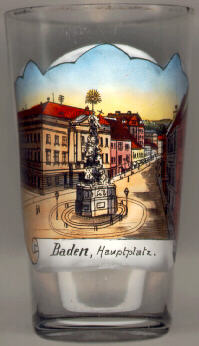
The  Trinity Column (Dreifaltigkeitssäule) [left, no. 121: centre]
was erected in 1714–1718 by the sculptor Giovanni Stanetti according to a design by the painter Martino Altomonte
as a memorial to the the Turkish invasions and the plague. In 1833, a fountain was added on its northern side as a memorial
to the unsuccessful attempt, in 1832, to assassinate Crown Prince Ferdinand (Austrian Emperor in 1835).
Trinity Column (Dreifaltigkeitssäule) [left, no. 121: centre]
was erected in 1714–1718 by the sculptor Giovanni Stanetti according to a design by the painter Martino Altomonte
as a memorial to the the Turkish invasions and the plague. In 1833, a fountain was added on its northern side as a memorial
to the unsuccessful attempt, in 1832, to assassinate Crown Prince Ferdinand (Austrian Emperor in 1835).
The  Town Hall (Rathaus) [left, no. 121: centre back]
was erected in 1815 by Josef Kornhäusel.
Town Hall (Rathaus) [left, no. 121: centre back]
was erected in 1815 by Josef Kornhäusel.
The  Kaiserhaus [left, no. 121: right, barely visible]
was built in 1792 for the financier Freiherr von Gontard. Later it was sold to Prince Esterházy
and then to the financier Freiherr von Arnstein. In 1813 is was bought by
Emperor Franz I who stayed here every summer until 1835.
Kaiserhaus [left, no. 121: right, barely visible]
was built in 1792 for the financier Freiherr von Gontard. Later it was sold to Prince Esterházy
and then to the financier Freiherr von Arnstein. In 1813 is was bought by
Emperor Franz I who stayed here every summer until 1835.
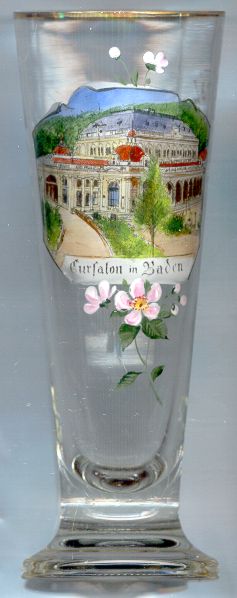
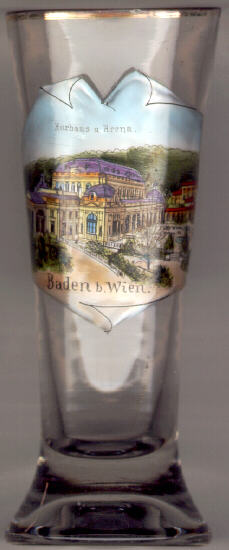
The  Kurhaus (now Casino) [left no. 1307, below no. 661, and right no. 129: centre]
was built in 1885/86 in place of several older spa buildings. Between 1934 and 1944
it served as gambling casino. From 1945 until 1955 it was occupied by the
Soviet Army. After the re-opening in 1956/57 it was used as event centre of the
city of Baden. Between 1968 and 1989 it served as congress centre. 1991–95 it
was it was remodelled and combined with the drinking hall (see below)
to house the new grand casino ('Congress Casino Baden').
Kurhaus (now Casino) [left no. 1307, below no. 661, and right no. 129: centre]
was built in 1885/86 in place of several older spa buildings. Between 1934 and 1944
it served as gambling casino. From 1945 until 1955 it was occupied by the
Soviet Army. After the re-opening in 1956/57 it was used as event centre of the
city of Baden. Between 1968 and 1989 it served as congress centre. 1991–95 it
was it was remodelled and combined with the drinking hall (see below)
to house the new grand casino ('Congress Casino Baden').
The  Sommerarena [right no. 129: back right, barely visible]
was built in 1905–06 in place of an older, wooden open-air theatre.
The new iron construction also included a glass roof. After World War II
it took until 1957 for the Arena to be opened again. The building was renovated
and enlarged several times since then.
Sommerarena [right no. 129: back right, barely visible]
was built in 1905–06 in place of an older, wooden open-air theatre.
The new iron construction also included a glass roof. After World War II
it took until 1957 for the Arena to be opened again. The building was renovated
and enlarged several times since then.
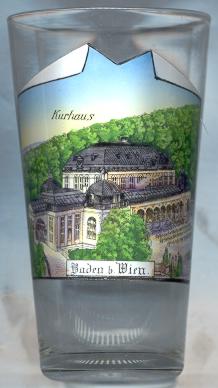
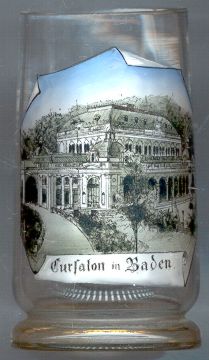
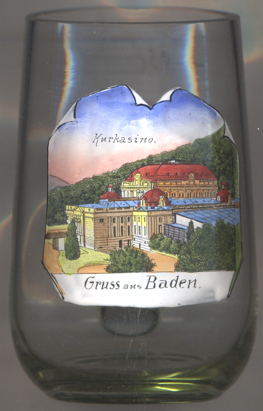
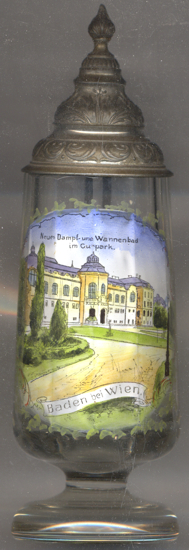
The  Municipal Spa (Städtische Kuranstalt)
[left no. 3364, and below, nos. 360 and 3776]
was built 1901–02 and replaced the original buildings of 1853–1901.
After 1945 the building fell into dereliction. In 1968–69 the Kuranstalt and the
old Parkhotel were combined, renovated and re-opened as the new Parkhotel.
Municipal Spa (Städtische Kuranstalt)
[left no. 3364, and below, nos. 360 and 3776]
was built 1901–02 and replaced the original buildings of 1853–1901.
After 1945 the building fell into dereliction. In 1968–69 the Kuranstalt and the
old Parkhotel were combined, renovated and re-opened as the new Parkhotel.
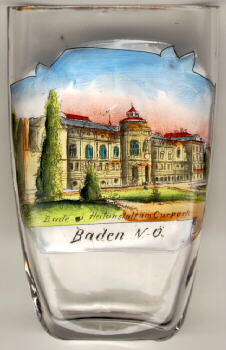
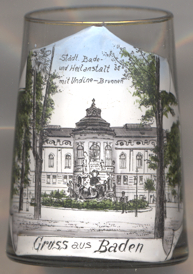
The  Undine fountain [near left, no. 3776: foreground]
was created in 1902–1903 to commemorate the completion of the water supply and canalisation that were constructed in
1898–1903. The sculptor was Josef Valentin Kassin, the model for the figure of Undine was Mercédèdes
Jellinek, for whom the car brands Mercedes and Mercedes-Benz had been named and whose family owned a summer residence
in Baden.
Undine fountain [near left, no. 3776: foreground]
was created in 1902–1903 to commemorate the completion of the water supply and canalisation that were constructed in
1898–1903. The sculptor was Josef Valentin Kassin, the model for the figure of Undine was Mercédèdes
Jellinek, for whom the car brands Mercedes and Mercedes-Benz had been named and whose family owned a summer residence
in Baden.
[http://www.planet-vienna.com/spots/undinebrunnen/undinebrunnen.htm, https://de.wikipedia.org/wiki/Datei:Baden_-_Kurpark_-_Undinebrunnen.jpg;
https://de.wikipedia.org/wiki/Mercédès_Jellinek]
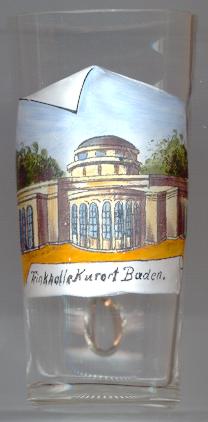
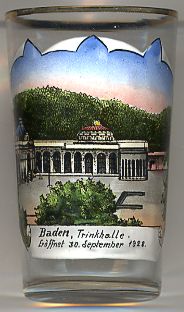
The  New Pump Room (Neue Trinkhalle)
was built in 1928 in place of an old bath house (Ursprungbad). It never was
used much for its intended purpose so that it was used later as event hall
and congress facility. From 1968 it was used as casino. The labeling on glass no. 2547 [right]
refers to the opening of the new pump room on 30 September 1928.
New Pump Room (Neue Trinkhalle)
was built in 1928 in place of an old bath house (Ursprungbad). It never was
used much for its intended purpose so that it was used later as event hall
and congress facility. From 1968 it was used as casino. The labeling on glass no. 2547 [right]
refers to the opening of the new pump room on 30 September 1928.
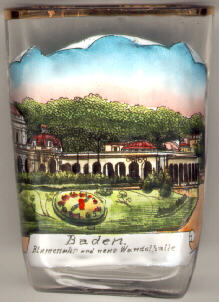 The
The  flower-clock (Blumenuhr) [near right no. 229: bottom left]
was presented to the city of Baden in 1928 by the Wallace company. Its original
location was at the Parkhotel. In 1928/29 it was moved to the Kurhaus
[this position is shown on the glass]. In 1992 it was moved again
and now is located near the Sommerarena.
flower-clock (Blumenuhr) [near right no. 229: bottom left]
was presented to the city of Baden in 1928 by the Wallace company. Its original
location was at the Parkhotel. In 1928/29 it was moved to the Kurhaus
[this position is shown on the glass]. In 1992 it was moved again
and now is located near the Sommerarena.
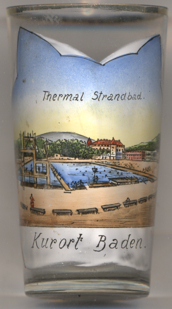 The
The  Thermal-Strandbad [left, no. 3897]
was created in 1926 according to the architct Alois Benn. At the time, the main building was Baden's second largest
building with a total length of 161 metres, second only to the nearby Weilburg palace (see below).
After restoration work in 1989 and 1992/1993, with the renovation completed in 1996, the lido became one of the largest
water parks in Austria. Nowadays about 300,000 people visit the bath annually.
Thermal-Strandbad [left, no. 3897]
was created in 1926 according to the architct Alois Benn. At the time, the main building was Baden's second largest
building with a total length of 161 metres, second only to the nearby Weilburg palace (see below).
After restoration work in 1989 and 1992/1993, with the renovation completed in 1996, the lido became one of the largest
water parks in Austria. Nowadays about 300,000 people visit the bath annually.
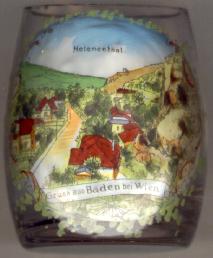
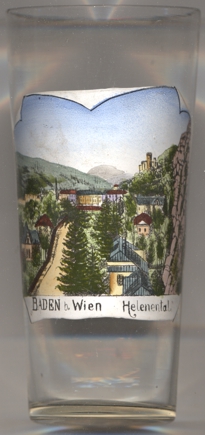
The valley of the river Schwechat upstream from Baden is called
 Helenental and always has been a
popular area for promenades. It received its name from the parish church
of St. Helena. The chanson "Ich kenn' ein kleines Wegerl im Helenental"
("I know a narrow path in the Helenental"), composed in 1940 by Alexander
Steinbrecher, was so popular that it has become almost a folk song.
Helenental and always has been a
popular area for promenades. It received its name from the parish church
of St. Helena. The chanson "Ich kenn' ein kleines Wegerl im Helenental"
("I know a narrow path in the Helenental"), composed in 1940 by Alexander
Steinbrecher, was so popular that it has become almost a folk song.
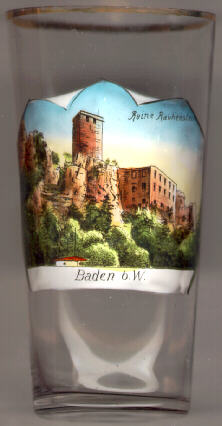
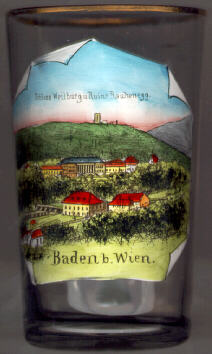
The entrance to the Helenental is guarded by the ruins of two castles:
 Schloss Rauhenstein [left, no. 349]
was first mentioned in 1160. The ruin consists of the remainders of the
stronghold of the 12th century, a chapel from the 13th century and
further parts added in the 17th century.
Schloss Rauhenstein [left, no. 349]
was first mentioned in 1160. The ruin consists of the remainders of the
stronghold of the 12th century, a chapel from the 13th century and
further parts added in the 17th century.
Archduke Karl, a younger brother of Emperor Franz II/I, became famous because he defeated Napoleon in a battle in May 1809
(see also the famous monument for Archduke Karl in Vienna).
After his defeat by Napoleon only two months later, Karl retired to Baden and decided to build a palace for
his family on the foot of the hill below the ruin of Schloss Rauheneck.
Archduke Karl's residence, called
The
Further building designed by Franz von Neumann depicted on glasses of this collection are the parish churches St. Anton
and Donaufeld in Vienna and the town hall of Liberec.
See also: Baden (CH), Baden-Baden (D).
 Schloss Rauheneck [right, no. 374: background top]
was first mentioned in 1136. Only remainders of buildings from the 12th and 13th century can be seen today.
Schloss Rauheneck [right, no. 374: background top]
was first mentioned in 1136. Only remainders of buildings from the 12th and 13th century can be seen today.

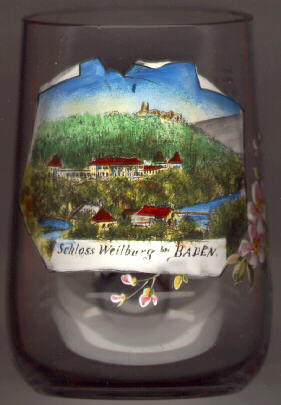
 Weilburg [left, no. 2130, right, no. 326, and below, no. 875],
was built 1820–23 by the architect Josef Kornhäusel and was the most important
example of classicist architecture in Austria. The palace received its name
from Karl's spouse, Archduchess Henriette, Princess of Nassau-Weilburg.
In 1919, their descendants had to leave Austria but remained in possession of the
palace since private property of the Habsburg family was exempt
from expropriation. During World War II the palace was occupied by the Wehrmacht in 1943.
In 1945 it was destroyed by fire. The ruins of the palace were
completely removed in 1964 to make place for a new residential area.
Weilburg [left, no. 2130, right, no. 326, and below, no. 875],
was built 1820–23 by the architect Josef Kornhäusel and was the most important
example of classicist architecture in Austria. The palace received its name
from Karl's spouse, Archduchess Henriette, Princess of Nassau-Weilburg.
In 1919, their descendants had to leave Austria but remained in possession of the
palace since private property of the Habsburg family was exempt
from expropriation. During World War II the palace was occupied by the Wehrmacht in 1943.
In 1945 it was destroyed by fire. The ruins of the palace were
completely removed in 1964 to make place for a new residential area.
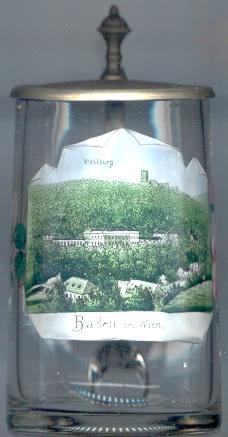
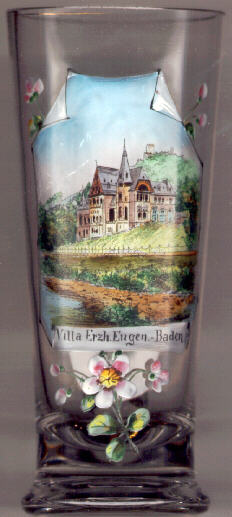
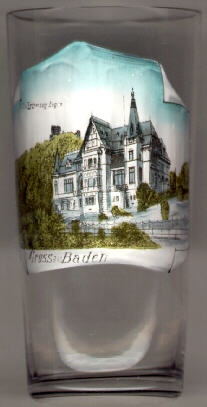
 Villa Erzherzog Eugen [leftt, no. 107; and right, no. 375]
was originally built for Archduke Wilhelm,
son of Archduke Karl, by the architect Franz Ritter von Neumann in German Neo-Renaissance style between 1883 and 1886.
After the death of Wilhelm, his son Archduke Eugen inherited the villa.
Eugen was the last Grand Master of the Teutonic Order (Hoch- und Deutschmeister)
and initiated its transformation in 1929 into a religious order. The villa
became derelict after World War II. After a complete renovation in 1976
it is now back in its original state.
Villa Erzherzog Eugen [leftt, no. 107; and right, no. 375]
was originally built for Archduke Wilhelm,
son of Archduke Karl, by the architect Franz Ritter von Neumann in German Neo-Renaissance style between 1883 and 1886.
After the death of Wilhelm, his son Archduke Eugen inherited the villa.
Eugen was the last Grand Master of the Teutonic Order (Hoch- und Deutschmeister)
and initiated its transformation in 1929 into a religious order. The villa
became derelict after World War II. After a complete renovation in 1976
it is now back in its original state.
![[scale]](lineal.jpg)